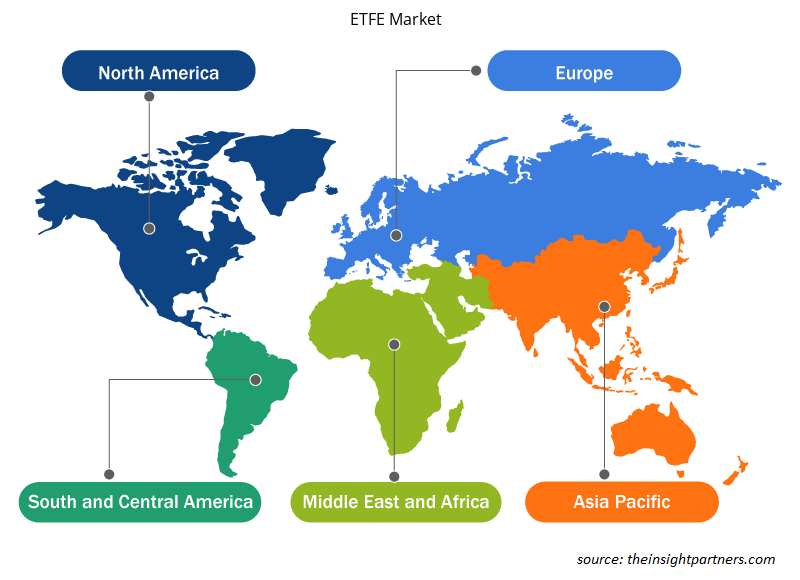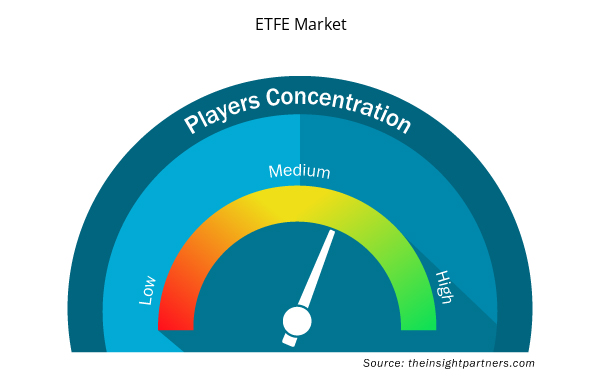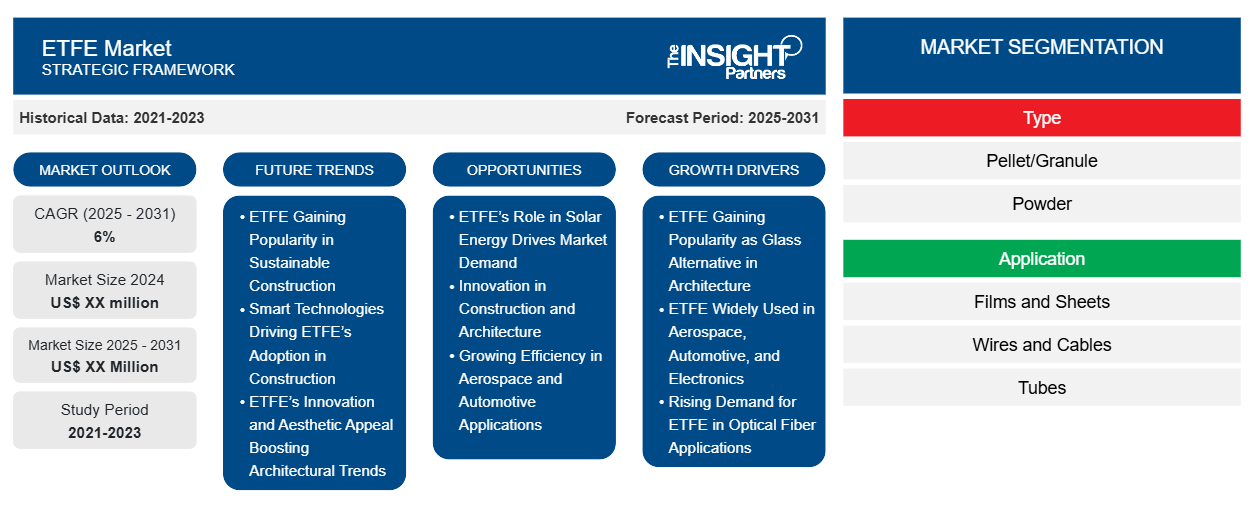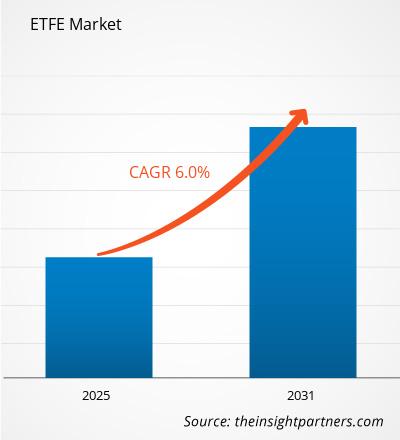Se espera que el mercado de ETFE registre una CAGR del 6 % entre 2024 y 2031, y que el tamaño del mercado se expanda de XX millones de dólares estadounidenses en 2024 a XX millones de dólares estadounidenses en 2031.
El mercado de ETFE cubre el análisis por tipo (pellets/gránulos, polvo); aplicación (películas y láminas, alambres y cables, tubos, revestimientos, otros); tecnología (moldeo por extrusión, moldeo por inyección, otros) y geografía (América del Norte, Europa, Asia Pacífico, Oriente Medio y África, y América del Sur y Central). El etileno tetrafluoroetileno (ETFE), un plástico a base de flúor, fue diseñado para tener una alta resistencia a la corrosión y fuerza en un amplio rango de temperaturas. El ETFE es un polímero cuyo nombre basado en la fuente es poli(eteno-co-tetrafluoroeteno). La lámina de ETFE es un polímero plástico relacionado con el teflón y se produce tomando la resina polimérica y extruyéndola en una película delgada.
Propósito del Informe
El informe ETFE Market de The Insight Partners tiene como objetivo describir el panorama actual y el crecimiento futuro, los principales factores impulsores, los desafíos y las oportunidades. Esto proporcionará información a diversas partes interesadas del negocio, como:
- Proveedores/fabricantes de tecnología: Para comprender la dinámica cambiante del mercado y conocer las oportunidades potenciales de crecimiento, lo que les permitirá tomar decisiones estratégicas informadas.
- Inversionistas: Realizar un análisis exhaustivo de tendencias sobre la tasa de crecimiento del mercado, las proyecciones financieras del mercado y las oportunidades que existen en toda la cadena de valor.
- Órganos reguladores: Regular las políticas y vigilar las actividades del mercado con el objetivo de minimizar los abusos, preservar la confianza de los inversores y defender la integridad y la estabilidad del mercado.
Segmentación del mercado de ETFE
Tipo
- Pellet/Gránulo
- Polvo
Solicitud
- Películas y láminas
- Alambres y cables
- Tubos
- Recubrimientos
Tecnología
- Moldeo por extrusión
- Moldeo por inyección
Geografía
- América del norte
- Europa
- Asia-Pacífico
- América del Sur y Central
- Oriente Medio y África
Personalice este informe según sus necesidades
Obtendrá personalización en cualquier informe, sin cargo, incluidas partes de este informe o análisis a nivel de país, paquete de datos de Excel, así como también grandes ofertas y descuentos para empresas emergentes y universidades.
- Obtenga las principales tendencias clave del mercado de este informe.Esta muestra GRATUITA incluirá análisis de datos, desde tendencias del mercado hasta estimaciones y pronósticos.
Factores impulsores del crecimiento del mercado de ETFE
- El ETFE gana popularidad como alternativa al vidrio en la arquitectura: el principal impulsor del crecimiento del mercado del ETFE es el segmento de la construcción. El ETFE se está utilizando rápidamente como una alternativa a las aplicaciones tradicionales que tienen vidrios en la arquitectura debido a sus propiedades de ligereza y durabilidad. El ETFE es adecuado para techos, fachadas y otras aplicaciones estructurales, ya que tiene buena transparencia, proporciona resistencia a la radiación UV y puede soportar condiciones climáticas extremas.
- El ETFE se utiliza ampliamente en la industria aeroespacial, automotriz y electrónica: al ser uno de los plásticos más resistentes y duraderos, el ETFE se utiliza ampliamente en otras aplicaciones además de la construcción. Tiene una excelente resistencia a la corrosión, a las altas temperaturas y a los productos químicos, y se utiliza en vehículos, en la industria aeroespacial y en la electrónica.
- Demanda creciente de ETFE en aplicaciones de fibra óptica: las aplicaciones emergentes en fibra óptica, en particular como material de revestimiento, también impulsan el mercado de ETFE. En este ámbito, se prevé una demanda en el campo de las telecomunicaciones y la transmisión de datos con materiales de alto rendimiento, lo que debería aumentar aún más el uso de ETFE.
Tendencias futuras del mercado de ETFE
- El ETFE está ganando popularidad en la construcción sostenible: este material se está volviendo popular en la industria de la construcción últimamente, ya que la industria ha estado adoptando el principio de la sostenibilidad. El ETFE es un material de construcción liviano, que minimiza la carga estructural del edificio. Por lo tanto, se consume menos energía durante el proceso de construcción y por el edificio en sí.
- Las tecnologías inteligentes impulsan la adopción del ETFE en la construcción: las tecnologías inteligentes en la construcción son las nuevas tendencias y el ETFE se está posicionando bien para aprovechar este cambio. La aplicación futura implicaría la incorporación de sensores o incluso revestimientos inteligentes en las películas de ETFE para poder detectar los cambios en el entorno en lo que respecta a la temperatura o el nivel de luz.
- La innovación y el atractivo estético del ETFE impulsan las tendencias arquitectónicas: al ser un material innovador con propiedades funcionales y estéticas, el ETFE probablemente será la solución preferida que los arquitectos y diseñadores consideren en los proyectos arquitectónicos modernos. La continua presencia de estas características en los diseños mantendrá la tendencia al alza en aplicaciones creativas en fachadas de edificios y sistemas de techado.
Oportunidades de mercado del ETFE
- El papel del ETFE en la energía solar impulsa la demanda del mercado: las fuentes de energía renovables, entre las que se incluye la energía solar, constituyen uno de los principales incentivos para la creciente demanda de ETFE. Debido a que el ETFE puede garantizar una transmisión de luz superior junto con durabilidad, generalmente se utiliza en la fabricación de paneles solares.
- Innovación en la construcción y la arquitectura: las actividades de construcción positivas, junto con un gran énfasis en los materiales de construcción relacionados con la innovación, hacen que América del Norte sea el mayor consumidor de ETFE. La enorme demanda de arquitectura contemporánea y prácticas ecológicas en la construcción seguirá demandando ETFE en el futuro cercano en esta región.
- Eficiencia creciente en aplicaciones aeroespaciales y automotrices: el injerto y otras investigaciones y desarrollos sobre ETFE proporcionarán futuras formulaciones que mejoren sus propiedades mecánicas y térmicas. Se espera que los futuros productos de ETFE muestren mayor resistencia a temperaturas extremas, radiaciones ultravioleta y exposiciones químicas, lo que los hará aún más eficientes en aplicaciones exigentes como la aeroespacial y la automotriz.
Perspectivas regionales del mercado de ETFE
Los analistas de Insight Partners explicaron en detalle las tendencias y los factores regionales que influyen en el mercado de ETFE durante el período de pronóstico. En esta sección también se analizan los segmentos y la geografía del mercado de ETFE en América del Norte, Europa, Asia Pacífico, Oriente Medio y África, y América del Sur y Central.

- Obtenga los datos regionales específicos para el mercado de ETFE
Alcance del informe sobre el mercado de ETFE
| Atributo del informe | Detalles |
|---|---|
| Tamaño del mercado en 2024 | XX millones de dólares estadounidenses |
| Tamaño del mercado en 2031 | US$ XX millones |
| CAGR global (2024 - 2031) | 6% |
| Datos históricos | 2021-2023 |
| Período de pronóstico | 2025-2031 |
| Segmentos cubiertos | Por tipo
|
| Regiones y países cubiertos | América del norte
|
| Líderes del mercado y perfiles de empresas clave |
|
Densidad de los actores del mercado de ETFE: comprensión de su impacto en la dinámica empresarial
El mercado de ETFE está creciendo rápidamente, impulsado por la creciente demanda de los usuarios finales debido a factores como la evolución de las preferencias de los consumidores, los avances tecnológicos y una mayor conciencia de los beneficios del producto. A medida que aumenta la demanda, las empresas amplían sus ofertas, innovan para satisfacer las necesidades de los consumidores y aprovechan las tendencias emergentes, lo que impulsa aún más el crecimiento del mercado.
La densidad de actores del mercado se refiere a la distribución de las empresas o firmas que operan dentro de un mercado o industria en particular. Indica cuántos competidores (actores del mercado) están presentes en un espacio de mercado determinado en relación con su tamaño o valor total de mercado.
Las principales empresas que operan en el mercado ETFE son:
- Compañía de vidrio Asahi
- Industrias Daikin, Ltd.
- DowDuPont
- Ensinger GmbH
- GuangzhouLichangFluoroplasticsCo.Ltd.
Descargo de responsabilidad : Las empresas enumeradas anteriormente no están clasificadas en ningún orden particular.

- Obtenga una descripción general de los principales actores clave del mercado ETFE
Puntos de venta clave
- Cobertura integral: el informe cubre de manera integral el análisis de productos, servicios, tipos y usuarios finales del mercado ETFE, proporcionando un panorama holístico.
- Análisis de expertos: el informe se compila sobre la base de un profundo conocimiento de expertos y analistas de la industria.
- Información actualizada: El informe asegura relevancia comercial debido a su cobertura de información reciente y tendencias de datos.
- Opciones de personalización: este informe se puede personalizar para satisfacer los requisitos específicos del cliente y adaptarse adecuadamente a las estrategias comerciales.
Por lo tanto, el informe de investigación sobre el mercado de ETFE puede ayudar a abrir camino para descifrar y comprender el escenario de la industria y las perspectivas de crecimiento. Si bien puede haber algunas preocupaciones válidas, los beneficios generales de este informe tienden a superar las desventajas.
- Análisis histórico (2 años), año base, pronóstico (7 años) con CAGR
- Análisis PEST y FODA
- Tamaño del mercado Valor/volumen: global, regional, nacional
- Industria y panorama competitivo
- Conjunto de datos de Excel



Report Coverage
Revenue forecast, Company Analysis, Industry landscape, Growth factors, and Trends

Segment Covered
This text is related
to segments covered.

Regional Scope
North America, Europe, Asia Pacific, Middle East & Africa, South & Central America

Country Scope
This text is related
to country scope.
Preguntas frecuentes
The growing construction industry is an emerging trend in the market.
The Asia Pacific market is expected to account for the highest CAGR over the forecast period due to the rising demand of ETFE in the region.
The extrusioon molding technology segment accounted for the largest market share in 2023.
Asahi Glass Company, Daikin Industries,Ltd, Dow, Ensinger GmbH, GuangzhouLichang FluoroplasticsCo.Ltd, HaloPolymer OJSC, Hubei Everflon Polymer Co.Ltd, Quadrant AG(Mitsubishi Chemical Corporation), The Chemours Company, and Vector Foiltec are some of the key players in the market.
The growing demand for ETFE from various application industries is a key driver in the market.
The ETFE Market is estimated to witness a CAGR of 6% from 2023 to 2031
Trends and growth analysis reports related to Chemicals and Materials : READ MORE..
1. Asahi Glass Company
2. Daikin Industries,Ltd.
3. DowDuPont
4. Ensinger GmbH
5. GuangzhouLichang FluoroplasticsCo.Ltd.
6. HaloPolymer OJSC
7. Hubei Everflon Polymer Co.Ltd.
8. Quadrant AG(Mitsubishi Chemical Corporation)
9. The Chemours Company
10. Vector Foiltec
The Insight Partners performs research in 4 major stages: Data Collection & Secondary Research, Primary Research, Data Analysis and Data Triangulation & Final Review.
- Data Collection and Secondary Research:
As a market research and consulting firm operating from a decade, we have published and advised several client across the globe. First step for any study will start with an assessment of currently available data and insights from existing reports. Further, historical and current market information is collected from Investor Presentations, Annual Reports, SEC Filings, etc., and other information related to company’s performance and market positioning are gathered from Paid Databases (Factiva, Hoovers, and Reuters) and various other publications available in public domain.
Several associations trade associates, technical forums, institutes, societies and organization are accessed to gain technical as well as market related insights through their publications such as research papers, blogs and press releases related to the studies are referred to get cues about the market. Further, white papers, journals, magazines, and other news articles published in last 3 years are scrutinized and analyzed to understand the current market trends.
- Primary Research:
The primarily interview analysis comprise of data obtained from industry participants interview and answers to survey questions gathered by in-house primary team.
For primary research, interviews are conducted with industry experts/CEOs/Marketing Managers/VPs/Subject Matter Experts from both demand and supply side to get a 360-degree view of the market. The primary team conducts several interviews based on the complexity of the markets to understand the various market trends and dynamics which makes research more credible and precise.
A typical research interview fulfils the following functions:
- Provides first-hand information on the market size, market trends, growth trends, competitive landscape, and outlook
- Validates and strengthens in-house secondary research findings
- Develops the analysis team’s expertise and market understanding
Primary research involves email interactions and telephone interviews for each market, category, segment, and sub-segment across geographies. The participants who typically take part in such a process include, but are not limited to:
- Industry participants: VPs, business development managers, market intelligence managers and national sales managers
- Outside experts: Valuation experts, research analysts and key opinion leaders specializing in the electronics and semiconductor industry.
Below is the breakup of our primary respondents by company, designation, and region:

Once we receive the confirmation from primary research sources or primary respondents, we finalize the base year market estimation and forecast the data as per the macroeconomic and microeconomic factors assessed during data collection.
- Data Analysis:
Once data is validated through both secondary as well as primary respondents, we finalize the market estimations by hypothesis formulation and factor analysis at regional and country level.
- Macro-Economic Factor Analysis:
We analyse macroeconomic indicators such the gross domestic product (GDP), increase in the demand for goods and services across industries, technological advancement, regional economic growth, governmental policies, the influence of COVID-19, PEST analysis, and other aspects. This analysis aids in setting benchmarks for various nations/regions and approximating market splits. Additionally, the general trend of the aforementioned components aid in determining the market's development possibilities.
- Country Level Data:
Various factors that are especially aligned to the country are taken into account to determine the market size for a certain area and country, including the presence of vendors, such as headquarters and offices, the country's GDP, demand patterns, and industry growth. To comprehend the market dynamics for the nation, a number of growth variables, inhibitors, application areas, and current market trends are researched. The aforementioned elements aid in determining the country's overall market's growth potential.
- Company Profile:
The “Table of Contents” is formulated by listing and analyzing more than 25 - 30 companies operating in the market ecosystem across geographies. However, we profile only 10 companies as a standard practice in our syndicate reports. These 10 companies comprise leading, emerging, and regional players. Nonetheless, our analysis is not restricted to the 10 listed companies, we also analyze other companies present in the market to develop a holistic view and understand the prevailing trends. The “Company Profiles” section in the report covers key facts, business description, products & services, financial information, SWOT analysis, and key developments. The financial information presented is extracted from the annual reports and official documents of the publicly listed companies. Upon collecting the information for the sections of respective companies, we verify them via various primary sources and then compile the data in respective company profiles. The company level information helps us in deriving the base number as well as in forecasting the market size.
- Developing Base Number:
Aggregation of sales statistics (2020-2022) and macro-economic factor, and other secondary and primary research insights are utilized to arrive at base number and related market shares for 2022. The data gaps are identified in this step and relevant market data is analyzed, collected from paid primary interviews or databases. On finalizing the base year market size, forecasts are developed on the basis of macro-economic, industry and market growth factors and company level analysis.
- Data Triangulation and Final Review:
The market findings and base year market size calculations are validated from supply as well as demand side. Demand side validations are based on macro-economic factor analysis and benchmarks for respective regions and countries. In case of supply side validations, revenues of major companies are estimated (in case not available) based on industry benchmark, approximate number of employees, product portfolio, and primary interviews revenues are gathered. Further revenue from target product/service segment is assessed to avoid overshooting of market statistics. In case of heavy deviations between supply and demand side values, all thes steps are repeated to achieve synchronization.
We follow an iterative model, wherein we share our research findings with Subject Matter Experts (SME’s) and Key Opinion Leaders (KOLs) until consensus view of the market is not formulated – this model negates any drastic deviation in the opinions of experts. Only validated and universally acceptable research findings are quoted in our reports.
We have important check points that we use to validate our research findings – which we call – data triangulation, where we validate the information, we generate from secondary sources with primary interviews and then we re-validate with our internal data bases and Subject matter experts. This comprehensive model enables us to deliver high quality, reliable data in shortest possible time.


 Obtenga una muestra gratuita de este informe
Obtenga una muestra gratuita de este informe